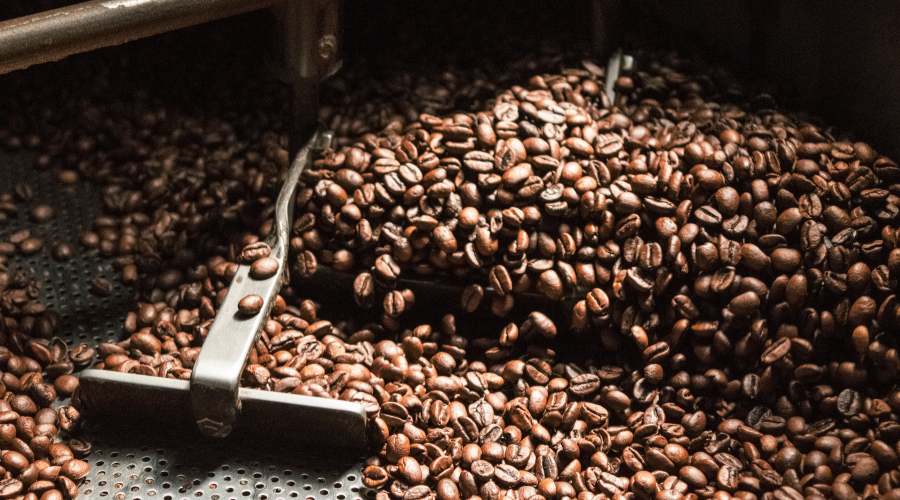The specialty coffee culture has seen exponential growth over the past decade, with more consumers seeking out high-quality, ethically-sourced beans that are expertly roasted.
This flourishing market presents an exciting opportunity for entrepreneurs with a passion for coffee to launch their own coffee roasting businesses.
In this comprehensive guide, we’ll outline the essential steps for establishing a successful coffee roasting enterprise.
Understanding the Coffee Roasting Business
Brief history of coffee roasting
Coffee roasting has been an essential part of coffee preparation since the 15th century, with the process evolving from rudimentary pan-roasting to the sophisticated roasting methods of today.
Mastering the art and science of coffee roasting is crucial for creating high-quality beans that capture the unique flavors and aromas of each coffee origin.
Market research: understanding your target audience
Before diving into the coffee roasting business, it’s crucial to research your target market. Identify potential customers, their preferences, and the specific demographics you want to cater to, such as specialty coffee enthusiasts, home baristas, or local cafes and restaurants.
This will help you develop a product line and marketing strategy that effectively reaches your desired audience.
Competition analysis: learning from established roasters
Studying your competition is vital to understanding the current landscape of the coffee roasting industry.
Analyze successful roasters’ offerings, marketing strategies, and customer engagement techniques to identify gaps in the market or unique selling points that can set your business apart.
Creating a Business Plan
Identifying your niche
- Single-origin vs. blends: Determine whether you want to focus on single-origin beans, which showcase the unique flavors of specific coffee-growing regions, or blended beans, which offer balanced and complex flavors by combining beans from multiple origins.
- Roast profiles: Decide on the roast profiles you’ll offer, from light and fruity to dark and bold. Experiment with various roast levels to create distinctive flavors that cater to diverse customer preferences.
- Organic, fair trade, and direct trade options: Consider offering ethically-sourced beans, which appeal to conscious consumers and contribute to sustainable coffee production.
Financial projections and budgeting
Develop a detailed financial plan that covers initial investments, ongoing expenses, and projected revenue.
Include costs for equipment, green coffee beans, packaging materials, marketing efforts, and facility rental, among others. Assess your break-even point and outline strategies for achieving profitability.
Marketing and branding strategies
Design a cohesive and memorable brand identity that reflects your company’s values and appeals to your target audience.
Develop a marketing plan that includes online and offline promotional activities, from social media campaigns to local events and partnerships.
Distribution channels: online, wholesale, and retail
Determine your primary distribution channels, such as online sales through your website, wholesale orders for cafes and restaurants, or retail sales in a brick-and-mortar store.
Each channel offers unique opportunities and challenges, so it’s essential to choose the ones that align with your business goals and resources.
Sourcing Green Coffee Beans
The importance of ethical sourcing
Sourcing green coffee beans ethically is crucial for ensuring fair compensation for coffee farmers and promoting sustainable practices.
Look for beans that are certified organic, fair trade, or part of direct trade programs, which foster transparent and equitable relationships between roasters and farmers.
Building relationships with coffee farmers and importers
Forge strong connections with coffee farmers or reputable importers who share your values and offer high-quality beans.
Building these relationships can help you secure a consistent supply of beans and stay informed about new and exciting coffee offerings.
Understanding coffee grading systems
Familiarize yourself with coffee grading systems, such as the Specialty Coffee Association (SCA) standards, which evaluate coffee beans based on factors like size, shape, color, and defects.
Understanding these grading systems can help you select the best green beans for your roasting business and ensure consistent quality in your products.
Storing and managing your green coffee inventory
Proper storage is essential for maintaining the quality of your green coffee beans. Store beans in a cool, dry, and dark environment, away from direct sunlight and strong odors.
Implement an inventory management system to keep track of your stock levels and ensure you always have enough beans on hand to meet customer demand.
Setting Up Your Roasting Facility
Selecting the right location
Choose a location for your roasting facility that meets your operational needs and complies with local zoning regulations.
Ensure that the space is large enough to accommodate your roasting equipment, green coffee storage, packaging area, and office space.
It’s also essential to factor in accessibility for deliveries and potential future expansion.
Choosing the appropriate roasting equipment
- Types of roasters: Research different roaster types, such as drum, fluid bed, and hybrid roasters, to determine the best fit for your business based on your roasting goals, capacity requirements, and budget.
- Sizing and capacity: Select a roaster with the appropriate size and capacity for your production needs. Keep in mind that as your business grows, you may need to upgrade to a larger roaster to meet increased demand.
- Maintenance and safety considerations: Regular maintenance is essential for ensuring the longevity and safe operation of your roasting equipment. Develop a maintenance schedule and invest in the necessary tools and spare parts to keep your roaster in optimal condition.
Ensuring proper ventilation and fire safety
Roasting coffee produces smoke and odors that require adequate ventilation to maintain a safe and comfortable working environment.
Consult with a local ventilation expert to design an effective system for your facility. Additionally, follow fire safety regulations and install fire extinguishers and alarms to protect your employees and property.
Obtaining required permits and certifications
Secure the necessary permits, licenses, and certifications for your coffee roasting business, which may include health department permits, food handling certifications, and local business licenses. Check your local and state regulations to ensure compliance.
Mastering the Roasting Process
Understanding roast profiles and roast levels
Familiarize yourself with the characteristics of different roast profiles, from light roasts that highlight the beans’ natural flavors to dark roasts that develop bold, smoky notes.
Mastering various roast levels allows you to create a diverse product lineup that appeals to a wide range of customers.
Developing a consistent roasting process
Creating a consistent roasting process ensures that your beans maintain a high level of quality and flavor across batches.
Monitor roast temperature, time, and airflow, and keep detailed records to fine-tune your process over time.
Experimenting with different roast profiles to create unique offerings
Don’t be afraid to experiment with different roast profiles and bean combinations to develop exclusive blends and limited-edition offerings.
This approach can help you stand out in the competitive coffee market and keep customers engaged and excited about your products.
Cupping and quality control
Regular cupping sessions are essential for assessing the quality and flavor profiles of your roasted beans.
Implement a quality control process that includes cupping, visual inspection, and aroma evaluation to ensure that your products consistently meet your standards.
Packaging and Labeling Your Coffee
Choosing the right packaging materials
- Barrier properties: Opt for packaging materials with high barrier properties to protect your beans from oxygen, moisture, and light, which can degrade their quality and freshness.
- Sustainability and recyclability: Consider using eco-friendly and recyclable packaging materials to minimize your business’s environmental impact and appeal to environmentally-conscious customers.
Designing eye-catching labels
Create visually appealing labels that reflect your brand identity and capture the attention of potential customers.
Work with a graphic designer to develop a cohesive design that effectively communicates your brand’s values and personality.
Providing clear and accurate information on labels
Ensure that your labels include essential information, such as roast level, origin, processing method, roast date, and any certifications (e.g., organic, fair trade).
Providing this information helps customers make informed decisions and demonstrates your commitment to transparency and quality.
Marketing and Building a Loyal Customer Base
Creating a strong online presence
- Website development: Build a professional and user-friendly website that showcases your products, shares your brand story, and allows customers to purchase your coffee online.
- Social media strategy: Develop a robust social media presence across platforms like Instagram, Facebook, and Twitter to engage with customers, showcase your products, and share behind-the-scenes content that highlights your passion for coffee roasting.
- Email marketing: Implement an email marketing campaign to keep customers informed about new products, promotions, and events, as well as to share valuable coffee-related content.
Participating in local events and coffee festivals
Engage with your local community by participating in events such as farmer’s markets, coffee festivals, and tasting events.
These opportunities allow you to showcase your products, connect with potential customers, and network with industry professionals.
Developing relationships with local cafes and retailers
Form strategic partnerships with local cafes, restaurants, and retailers to offer your coffee beans as their preferred or exclusive coffee supplier.
Establishing these relationships can help expand your customer base and increase your brand’s visibility.
Offering exceptional customer service and support
Provide outstanding customer service by being responsive, knowledgeable, and friendly.
Cultivate a loyal customer base by going the extra mile to ensure satisfaction, such as offering personalized recommendations, addressing concerns promptly, and fostering genuine connections with your customers.
Scaling Your Coffee Roasting Business
Expanding your product line
As your business grows, consider introducing new products, such as flavored coffee, limited-edition seasonal blends, or coffee-related merchandise, to diversify your offerings and generate additional revenue streams.
Investing in larger roasting equipment
Upgrade to larger roasting equipment as your production needs increase, allowing you to fulfill larger orders and meet the demands of a growing customer base.
Developing strategic partnerships
Form alliances with other businesses, such as co-branding partnerships or collaborations with complementary products, to expand your market reach and strengthen your brand.
Considerations for international expansion
If you’re looking to grow beyond your local market, explore opportunities for international expansion, including exporting your beans, attending international coffee events, and partnering with global distributors.
Conclusion
Starting a coffee roasting business can be a rewarding and fulfilling venture for those with a passion for coffee and a dedication to quality.








